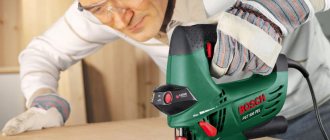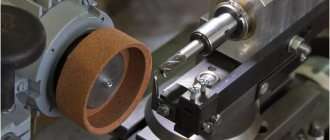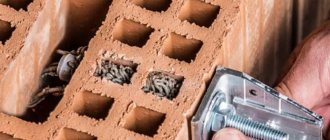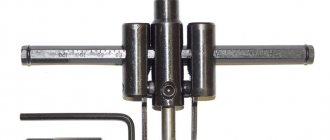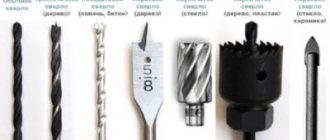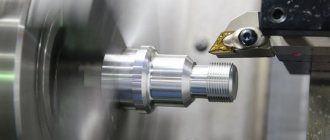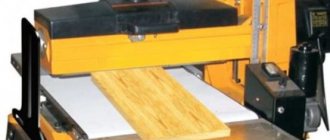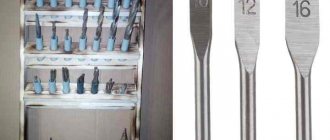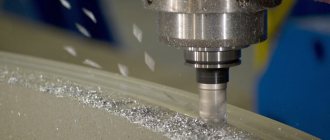A jigsaw is a hand-held tool designed for cutting various materials at home. With its help you can get straight, round, oval, and curly cuts. Moreover, the tool is able to cope not only with wood, but also with materials of varying strength. However, in order to achieve an accurate cut, you need to know the features of preparing the tool for work, and how to use a jigsaw correctly. Otherwise, the final result will differ from the desired one.
To cut thin and thick materials you need different jigsaw files
General cutting principles
It should be understood that a jigsaw produces an uneven cut. And to minimize the spread of the saw, you don’t need to make any special efforts when working with the tool. Simply press it to the surface of the material and set the direction of movement. The slower the cutting, the higher its quality.
Other general recommendations on how to use a jigsaw:
- During the cut, you need to constantly monitor the sharpness of the file and, if necessary, replace it in a timely manner. As soon as it becomes dull, the instrument begins to behave unpredictably.
- You should monitor the temperature of the cutting surface and avoid overheating. After all, this leads to rapid wear of the saw teeth.
- There are many types of jigsaw files. And each of them is designed for a specific type of material. To do quality work, you need to take this into account.
- Its functionality directly depends on the power of the tool. The higher this indicator, the more types of materials it can cut.
- Files with large teeth should be used for thick materials, and with small teeth - for thin materials.
- To get the most even seam, you should use additional devices such as a side stop, a jig, or a guide rail. This will allow you to move the tool through the material as smoothly as possible.
Important! As a guide when working with a jigsaw, you can choose any material with a smooth edge; the main thing is to align it correctly and secure the supporting end.
Additional tips for choosing saws
The quality of the saw blades should be even better than the quality of the jigsaw itself, because it is the dull teeth that easily bend in different directions that can ruin the work of even the most experienced craftsman.
In addition, it makes sense to choose different saws for different types of cutting:
- For straight cuts, wide blades are suitable, they have greater stability and, accordingly, ensure a straight line in the end.
- The more important the cleanliness of the cut itself, the finer the teeth on the blade are selected.
- If it is necessary to achieve a perfectly clean cut line, absolutely without a single chip, choose a blade that has a reverse tooth stroke.
- When there is a need for quick and rough cutting, large saws with widely spaced cutters are used.
- Saws without routing are quite productive and convenient for working with thick workpieces.
- If both productivity and cutting quality are equally important, then saws with teeth installed with a displaced pitch will help (at the bottom the pitch is large, and as it approaches the front part of the part it gradually becomes smaller).
Features of preparing a jigsaw for work
At the stage of preparing the tool for work, you need to inspect it for damage and check the integrity of the power cable. You also need to immediately prepare all the files that may be needed to complete the task and set up the appropriate modes.
Before cutting, mark the material.
When purchasing, it is better to choose a tool equipped with a laser guide.
How to assemble a manual jigsaw
When the material has been selected and the contour to be cut has been drawn, you can begin assembling the working tool. First of all, we tighten the file in the lower fastening (at the handle), after which we thread the free end into the opposite groove and, slightly squeezing the frame, fix it in it. Be sure to remember that the teeth of the saw blade should always face the handle of the tool.
When compressing, do not put strong pressure on the frame, trying to bend the metal arc. It is enough for the fasteners to come closer to each other by about 1 cm. You can squeeze the metal frame in your hand, or by resting the tool with the handle on your chest. For devices with tubular arches, there are special devices with grooves. If you can’t tighten the lambs with your bare hand tightly enough, use pliers.
If the saw blade is installed correctly, it does not dangle, and during operation there is a high-pitched sound of teeth biting into the material. It is better to understand how to properly assemble a jigsaw from the very beginning, since thin files tend to burst. The easier the process of assembling the device is for you, the more enjoyable it will be to work.
How to work with a jigsaw: features and rules
Depending on the type of material, the rules for making a cut are slightly different. And to avoid mistakes, you need to familiarize yourself with how to work with a jigsaw in a given case.
How to cut metal
When cutting metal, you should use a fine-toothed file. For thin and soft materials such as copper, aluminum, the speed can be set higher. A level above 750 W is considered optimal. And to reduce the friction force, you should periodically drip oil during operation.
Important! When cutting sheet metal, it is better to place plywood under it, which will reduce vibration.
How to cut wood, chipboard, plywood
The largest range of files is presented specifically for cutting these materials. But they must be used for their intended purpose. The number of strokes should be set based on the maximum values of the tool.
To make a cut in this case, you will need files with large teeth from 2 to 6 mm. The more complex the type of work, the smaller their size. A straight cut can be made at high speeds, and with a curly cut, the rotation speed can be reduced.
Having mastered the basic principles of how to properly work with an electric jigsaw on wood, plywood and chipboard, not only an adult, but also a child will be able to cope with such a task.
How to cut metal tiles
In this case, the greatest difficulty is the metal tile profile. And, in order to make the cut correctly, it is recommended to secure a sheet of material between the bars on both sides. This will eliminate vibration and create a certain gap for comfortable work.
Important! In order not to spoil the metal tile coating during the cut, you need to wrap the sole of the tool with a cloth.
How to cut plexiglass, plastic
For cutting this material, the same files as for metal are suitable. The pendulum stroke should be set to the minimum position or turned off completely. Plastic and plexiglass need to be processed at minimum speed.
How to cut ceramics, porcelain tiles
When cutting these types of materials, you should use files with an abrasive edge. In this case, the pendulum motion must be turned off, and the work process must proceed at maximum speed. To cut ceramics and porcelain stoneware, you should rarely use a jigsaw, as these files quickly become unusable and require replacement.
How to cut laminate
When cutting this material, the only difficulty is that chips form along the edge. To avoid this, you must use a saw with diversified teeth. And at the same time, make the cut not from the front, but from the inside.
For laminate, you can also use a file with teeth oriented downward from the jigsaw.
Why do you need a jigsaw?
The most widespread use of a jigsaw is in the field of woodworking:
- for cutting wood, fiberboard, chipboard, plywood and others;
- for working with miniature workpieces;
- for the production of decorative elements.
Thanks to its precise and accurate cutting, a jigsaw is an integral tool in a carpentry workshop, furniture production, and is also often used in everyday life. With the right equipment, the tool can be used for cutting tiles, drywall, cutting plastic, laminate, ceramic tiles and thin metal. The capabilities of a jigsaw largely depend on its power and type.
Features of cutting straight elements
This type of work with a jigsaw does not require complex manipulations. It is enough to make a marking and smoothly move the tool along it. But you can also make the process easier by using special devices.
Sawing with a guide bar
This metal ruler has a groove, which is necessary for installing a special jigsaw sole and can greatly simplify the work. When using a guide bar, you first need to make a marking and then fix it. In this case, the jigsaw moves along the device and makes an even cut.
Using the rip fence
All models of jigsaws from Bosch, Interskol and other manufacturers have a hole in the sole for a rip fence bar. This device ensures an even cut of various materials. But when using it, you need to press the jigsaw tightly onto an absolutely flat surface.
Important! It is not recommended to install a parallel stop on parts that will move to the side when cutting.
In most cases, a parallel stop is included with the tool.
Terms of use
Almost everyone knows the general rules of how to use a jigsaw, but there are many important features in working with this device. Of course, it all depends on the material the power tool is working with, but below are some general guidelines.
Tips on how to use a jigsaw:
- There is no need to press in the direction of the cut; the jigsaw should move freely on its own. If the tool does not work, the file is dull. If you put too much pressure on the file, it will move to the side and ruin the cut.
- Here's how to properly use a jigsaw for finishing sawing: the pendulum stroke is set by the regulator to 0, and if thicker boards are being cut in the direction of the grain, then the regulator is set to 1.
- The pendulum mode is used when cutting along the fiber, helping the file not to go to the side.
- During operation, the part must be fixed using clamps. Since you can work with a jigsaw with one hand, some novice specialists, in order to save time, hold the part itself in the second. But in this position it will be impossible to guide the power tool in a straight line. For a more accurate cut and work safety, the part is fixed.
- During work, a lot of dust and sawdust is generated in a short period of time, so using glasses for protection will not be superfluous. If a splinter (especially a metal one) gets into the eye, not only the cut will be damaged, but also the vision.
- In the rules on how to use a jigsaw, it is impossible not to mention that you need to cut not along the intended line, but nearby. This way the cut comes out more accurately and when marking you can avoid including a tolerance for the cut itself.
- To make the cut on the front side smoother and more beautiful, the part is placed face down while working. However, this rule does not apply in the case of thick workpieces. And if there are doubts about the possibility of strictly maintaining the markings on the reverse side in this way, then it is better to use special inserts.
- Sometimes just using a jigsaw as your main tool is not enough. You need to choose the most suitable tool for each manipulation. For example, in woodworking, if the task is simply to saw straight through a long piece in the direction of the grain, a circular saw (if available, of course) or a hacksaw would be more appropriate than a jigsaw. After all, a hacksaw, although rougher, cuts more straight.
- When sawing metal workpieces, it is advisable to use the maximum stroke frequency and turn off the pendulum mechanism altogether.
- How to use a jigsaw from the experience of professionals when working with plastic? It can be taken into account that a high frequency during the cutting process leads to melting, so you need to choose the lowest possible frequency.
- To make the cut exactly straight, you can use a guide limiter. Such a device is attached to the base of the power tool and pressed against the edge of the part.
- If you have to deal with pattern cutting, then first drill a hole for the saw at the point where the marking begins. The saw is inserted into this hole and cutting begins in accordance with the markings.
- To cut a bevel, you need to know how to use a jigsaw at an angle: for this purpose, they have provided the ability to tilt the sole at whatever specific angle is intended.
- When the jigsaw is powered, it is very important to ensure free movement of the cable.
The quality of the saw blades should be even better than the quality of the jigsaw itself, because it is the dull teeth that easily bend in different directions that can ruin the work of even the most experienced craftsman.
In addition, it makes sense to choose different saws for different types of cutting:
- For straight cuts, wide blades are suitable, they have greater stability and, accordingly, ensure a straight line in the end.
- The more important the cleanliness of the cut itself, the finer the teeth on the blade are selected.
- If it is necessary to achieve a perfectly clean cut line, absolutely without a single chip, choose a blade that has a reverse tooth stroke.
- When there is a need for quick and rough cutting, large saws with widely spaced cutters are used.
- Saws without routing are quite productive and convenient for working with thick workpieces.
- If both productivity and cutting quality are equally important, then saws with teeth installed with a displaced pitch will help (at the bottom the pitch is large, and as it approaches the front part of the part it gradually becomes smaller).
Sawing with a saw table
This design allows you to significantly simplify the process of cutting different materials. When using, you need to move not the tool, but the workpiece. This allows you to control the marking line without much difficulty. But at the same time, increased forces on the surface being processed should be avoided.
You can buy a saw table or assemble it yourself
Hand jigsaw device
A manual jigsaw (due to its size is also called a “mini jigsaw”) does not have many parts.
Hand jigsaw device
The basis is a metal bow. Made from spring-loaded steel. The shape is not flat, but slightly curved out of the plane along the transition radius. Acts as a cutting blade tensioner.
Clamps are installed at the ends (tips) of the bow. Socket nuts are most often used due to their simplicity and speed of operation. They can be tightened and unscrewed without the use of special keys or equipment.
The handle on one of the arms is used to hold the hand while working.
The cutting blade is a steel plate with teeth. Installed in fastenings and stretched with a bow.
The most common breakdowns, how to avoid them and safety precautions
High-quality jigsaws such as Bosch, Vortex, Zubr have a long service life. But even these tools can break down from time to time.
Common problems:
- If metal dust gets into the case, the start button may stop working. In this case, it should be cleaned with a special vacuum cleaner and, if necessary, replaced.
- The tool rod often fails because it is subjected to increased mechanical stress. As a result, a breakdown occurs and the fixing device connected to it deteriorates. This occurs when dust and particles of various materials get inside the housing. Good quality jigsaws do not have such problems.
- Engine stops often occur as a result of burnout of the stator, rotor, or wear of a notch on the shaft. In this case, the parts must be replaced.
Important! When performing various types of work, the power of the jigsaw should be taken into account.
Selection principles
When choosing a tool you need to consider:
- Electric motor power. The higher it is, the more opportunities open to the master.
- Availability of power regulator. It is necessary when you need to frequently cut different materials.
- Possibility of adjusting the angle of the saw blade. This additional feature allows you to use the tool in hard-to-reach places.
- Platform material. If it is plastic, any fall may cause it to break. On sale you can find models with metal soles.
- Cable length. The bigger, the better.
- File type. You need to buy several types of equipment and paste for cooling the metal in advance.
When choosing a tool, you need to hold it in your hands to feel how convenient it is. Some modern models are equipped with a laser designator and a flashlight that illuminates the work area. These are optional functions, but they make the work process easier and allow you to make even cuts.
Jigsaw (Photo: Instagram / trudyagadv.ru)
Advantages and disadvantages
Advantages of jigsaws:
- The work process is simplified.
- You don't need to buy expensive industrial equipment to cut metal workpieces.
- Using a power tool you can make straight cuts.
- Compared with stationary units, using a jigsaw you can cut parts in hard-to-reach places.
Flaws:
- High price of equipment for power tools.
- Over time, the files become dull and break. You need to regularly buy new equipment.
- In order not to spoil the metal on the cuts, it is necessary to use a special cooling lubricant.
A jigsaw is necessary for builders and installers who work with metal, wood, and plastic.
Manufacturers and cost
In construction stores you can find tools for cutting metal, wood, and plastic from the following companies:
- Makita is a Japanese manufacturer of power tools. Produces high quality products.
- DeWalt is an American company that produces professional tools for construction work. The price is justified by quality, power, reliability.
- Bosch is a German manufacturer that produces tools for professionals and amateurs.
- Skil is a German manufacturer that produces power tools for construction. The products of this company are of good quality.
- Hitachi is a concern of 1,100 companies that develop equipment for large enterprises and produce power tools.
Among the budget manufacturers we can highlight Interskol, Diold, Zubr.
Jigsaw brand "Maquitta" (Photo: Instagram / joyridertools)
Jigsaw safety and maintenance
Safety precautions must be followed when using this tool. It is important not only to know how to sit correctly when working with a jigsaw, but also how to hold it so as not to cause injury.
Primary requirements:
- sit upright, half sideways to the cutting table;
- securely fasten the file;
- Make the cut on a flat surface after fixing;
- cut at a distance of 40 cm from the eyes;
- use special glasses;
- securely secure the handle of the tool so that it does not slip.
Knowing how to use a jigsaw correctly, you can cut any material without much difficulty. Indeed, unlike hand tools, it is able to cope with the task much faster. The main thing is to follow the instructions included with the jigsaw in order to correctly calculate the load and avoid injuries.
Step-by-step instructions for curved cutting
If with a straight cut everything is more or less clear, then for pattern cutting you will have to “sweat a little”.
Stages of curved cutting:
A file is selected. When the degree of rounding is not particularly large, then the standard version of the canvas is suitable. In case of sharper rounding, it is necessary to use narrower blades
However, here too it is important to find a middle ground, because an excessively narrow blade will resist being pulled to the side during the cutting process. As mentioned earlier, the cut begins with drilling a hole for the saw. If the radius is small, then during the work you will need to keep a reference point depending on the position of the canvas, because all sorts of marking points can lead you off the required course. Moving along the marking, the jigsaw is guided, turning around the axis of the part. No lateral force required
You cannot push the tool forward - it must move calmly.
https://youtube.com/watch?v=XfMH7LWuwKE
How to cut a tree
Choosing a file. Cutting wood species is carried out using standard saws with medium-sized teeth pointing upward with a tooth pitch of 2.5 to 4 mm. The length of the file is selected in accordance with the thickness of the workpiece.
Stroke frequency. The stroke frequency is set to maximum. This indicator should be reduced only when the canvas is prone to overheating or discomfort is felt during operation.
Pendulum stroke. To increase the sawing speed, it is necessary to turn on the pendulum stroke. It negatively affects the quality of the cut, so it should be used in cases where fast work is important, but the quality of the cut is not particularly important.
Sawing process. You should work on the back side of the material to avoid damage to the product. Before sawing, the workpiece must be marked. When sawing, the tool must be pressed evenly to the surface and guided smoothly. There is no need to push it forward much, because as the cut progresses, it moves through the material, especially when the pendulum mechanism is turned on.
How to saw plastic
Choosing a file. It is better to use a blade with a small tooth, similar to that for metal. This will improve the overall quality of work.
The jigsaw settings are set individually, depending on the type of plastic.
Pendulum stroke. To obtain an even cut, the pendulum stroke is set to the minimum position or turned off completely.
Stroke frequency. Speed – no more than 40% of the maximum.
Installing the saw blade backwards
It would seem, well, why mock the instrument so much. But don't rush to conclusions. Sometimes this "trick" can be very useful.
For example, in a situation like in the photo below.
We need to cut a square hole in a wooden piece, but this will not work in the classical way.
Then we simply install the saw backwards (so that the teeth point backwards) and cut out the “inconvenient” piece without any problems.
How to saw metal
Choosing a file. For cutting metal surfaces, saws with fine teeth are used - tooth pitch 1 - 2 mm. Visually, such a file resembles a hacksaw blade for metal and can be used for cutting other materials in order to improve the cleanliness of the cut.
Stroke frequency. The sawing speed must be set as low as possible.
Pendulum mechanism. The pendulum stroke is completely disabled.
Sawing process. The tool must be moved slowly across the workpiece, without pressure. The sheet of tin must be firmly secured in advance by positioning it so that the cut line is as close as possible to the support.
If it is necessary to make a curved cut in thin sheet metal, but it is not possible to position the workpiece so that the cut line is close to the support, then it must be placed between two sheets of fiberboard or hardboard. All markings are applied to the top sheet of fiberboard. This will prevent the formation of burrs.
It is also recommended to take short breaks in work and use additional cooling sources to avoid overheating of the file.
Jigsaw care
Like any mechanism, a jigsaw requires care and maintenance. Especially if you use it frequently and intensively.
Practice shows that to increase the service life of a jigsaw, you need to regularly lubricate the gearbox and rod. In addition, lubricated tools are quieter and smoother.
The jigsaw motor shaft rotates on ball bearings. They are durable and can work without additional lubrication for the entire service life of the tool. But a jigsaw is not only an electric motor.
The rotation of the shaft is converted by a special mechanism into a reciprocating movement of the jigsaw rod. The pumping device adds longitudinal vibrations of the rod back and forth to these up and down movements. All this complex mechanics is assembled on plain bearings. The loads from the working nozzle are transferred to them. It’s a no brainer that lubrication is a vital component here.
For jigsaws, consistent types of lubricant are used. They must be sufficiently refractory. During operation, the mechanism heats up from friction in the nodes and from nearby electrical windings of the motor. In this case, ordinary lubricants are liquefied and squeezed out of the friction pairs.
We have selected a video for you that shows disassembling a jigsaw for subsequent lubrication:
